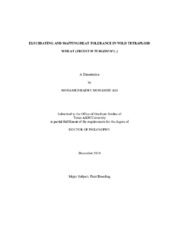| dc.contributor.advisor | Ibrahim, Amir | |
| dc.creator | Ali, Mohamed Badry Mohamed | |
| dc.date.accessioned | 2012-02-14T22:18:47Z | |
| dc.date.accessioned | 2012-02-16T16:12:08Z | |
| dc.date.available | 2012-02-14T22:18:47Z | |
| dc.date.available | 2012-02-16T16:12:08Z | |
| dc.date.created | 2010-12 | |
| dc.date.issued | 2012-02-14 | |
| dc.date.submitted | December 2010 | |
| dc.identifier.uri | https://hdl.handle.net/1969.1/ETD-TAMU-2010-12-8888 | |
| dc.description.abstract | Identifying reliable screening tools and characterizing tolerant germplasm sources is essential for developing wheat (Triticum aestivum L.) varieties suited for the hot areas of the world. Our objective was to evaluate heat tolerance of promising wild tetraploid wheat (Triticum turgidum L.) accessions that could be used as sources of heat tolerance in common- and durum-wheat (Triticum durum) breeding programs.
We screened 109 wild tetraploid wheat accessions collected by the International Center for Agriculture Research in the Dry Areas (ICARDA) from the hottest wheat growing areas in Africa and Asia, as well as, two common wheat checks for their response to heat stress by measuring damage to the thylakoid membranes, flag leaf temperature depression (FLTD), and spike temperature depression (STD) during exposure to heat stress for 16 beginning at anthesis. Measurements were taken on the day of anthesis then 4, 8, 12, and 16 days post anthesis (DPA) under controlled optimum and heat-stress conditions. Individual kernel weight (IKW) and heat susceptibility index (HSI) measurements were also obtained. Prolonged exposure to heat stress was associated with increased damage to thylakoid membranes, as indicated by the high ratio of constant fluorescence (O) to peak variable fluorescence (P).
A positive and significant correlation was found between O/P ratio and both FLTD and STD under heat-stress conditions. A negative and significant correlation was found between FLTD and HSI and between STD and HSI based on the second and third measurements (4 and 8 DPA). Correlations obtained after the third measurement were not significant because heat-stress accelerated maturity and senescence.
For a pedigree-based mapping strategy a family approach was then developed by crossing and back-crossing heat-tolerant and heat-susceptible germplasm. A set of 800 lines resulting from the pedigree-based family approach was phenotyped using FLTD, chlorophyll content and yield and its components under heat stress. Genotyping of these lines was accomplished using simple sequence repeat (SSRs) markers. Some QTLs associated with heat stress tolerance were identified. This study identified potential heat-tolerant wild tetraploid wheat germplasm and QTL conditioning heat tolerance that can be incorporated into wheat breeding programs to improve cultivated common and durum wheat. | en |
| dc.format.mimetype | application/pdf | |
| dc.language.iso | en_US | |
| dc.subject | Quantitative Trait Loci | en |
| dc.subject | Heat Susceptibility Index | en |
| dc.subject | Flag Leaf Temperature Depression | en |
| dc.subject | Spike Temperature Depression | en |
| dc.subject | Variance Component | en |
| dc.subject | Pedigree Wide Regression | en |
| dc.subject | Linkage Disequilibrium | en |
| dc.subject | Association Analysis | en |
| dc.title | Elucidating and Mapping Heat Tolerance in Wild Tetraploid Wheat (Triticum turgidum L.) | en |
| dc.type | Thesis | en |
| thesis.degree.department | Soil and Crop Sciences | en |
| thesis.degree.discipline | Plant Breeding | en |
| thesis.degree.grantor | Texas A&M University | en |
| thesis.degree.name | Doctor of Philosophy | en |
| thesis.degree.level | Doctoral | en |
| dc.contributor.committeeMember | Hays, Dirk | |
| dc.contributor.committeeMember | Rudd, Jackie | |
| dc.contributor.committeeMember | Payne, William | |
| dc.type.genre | thesis | en |
| dc.type.material | text | en |


